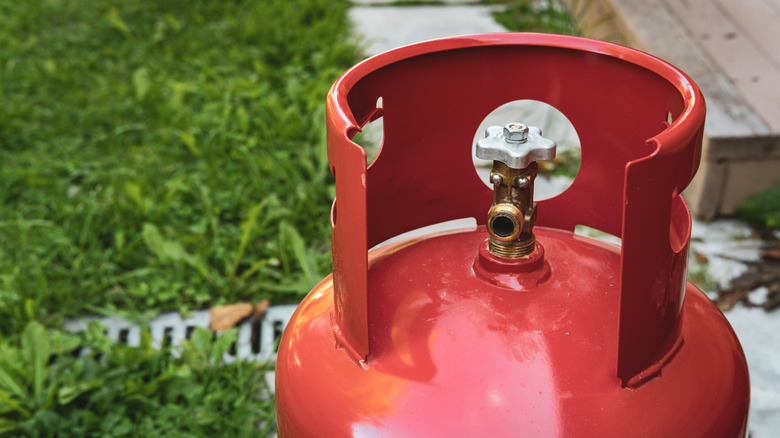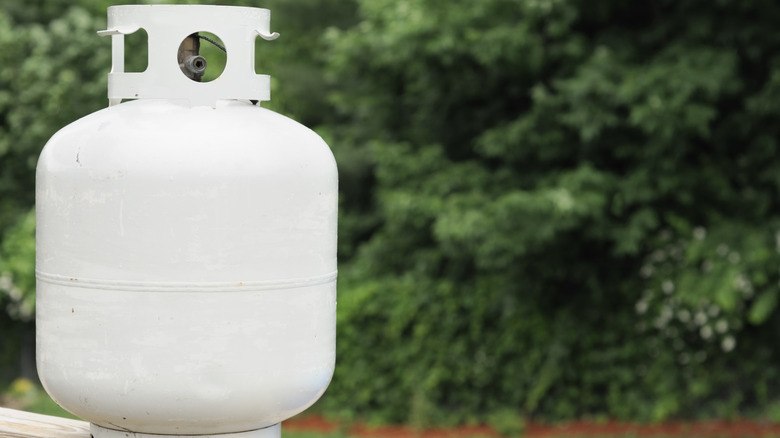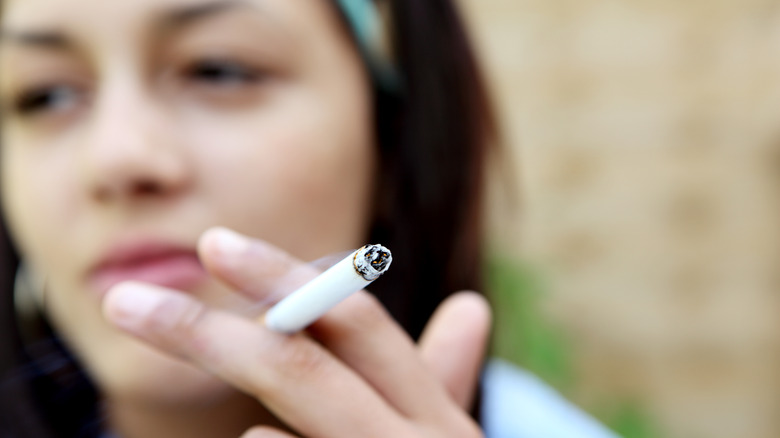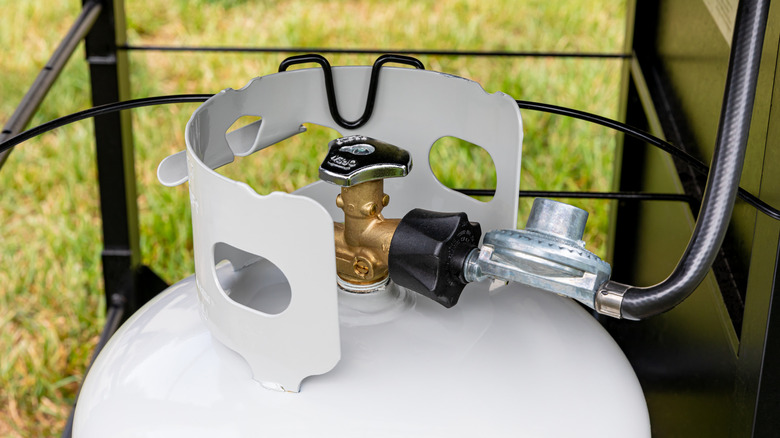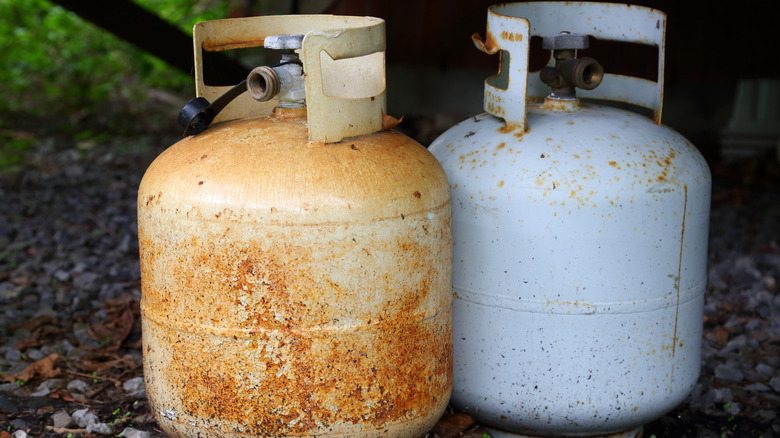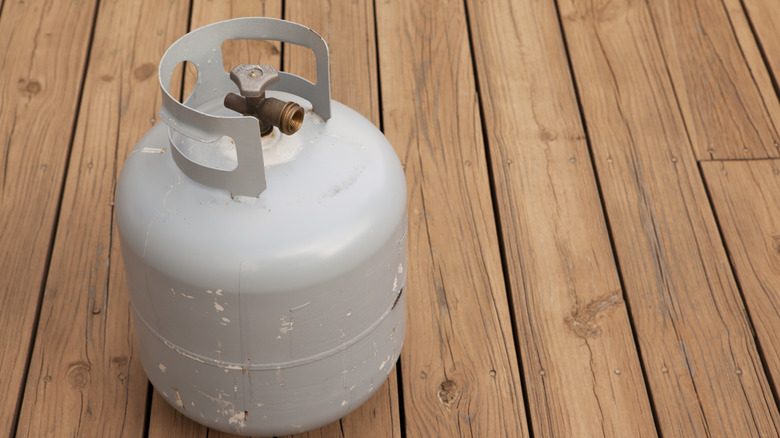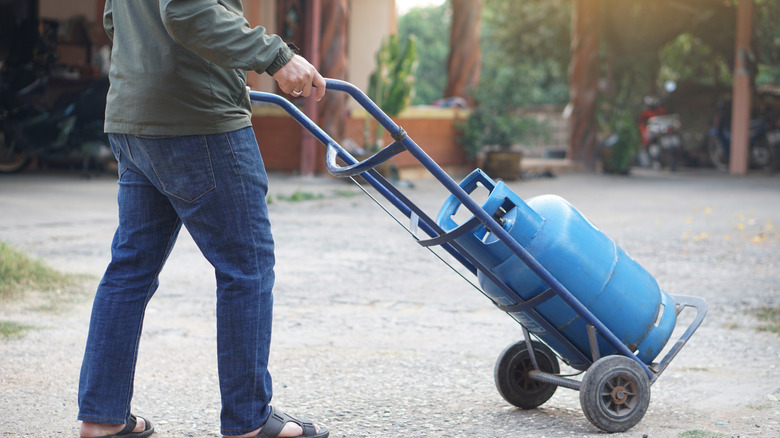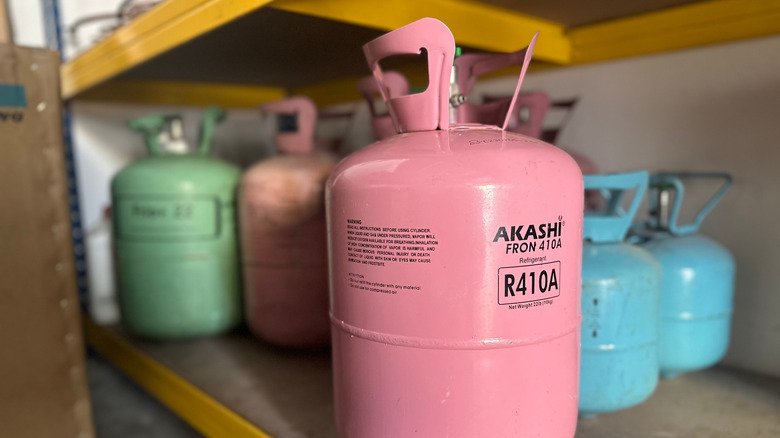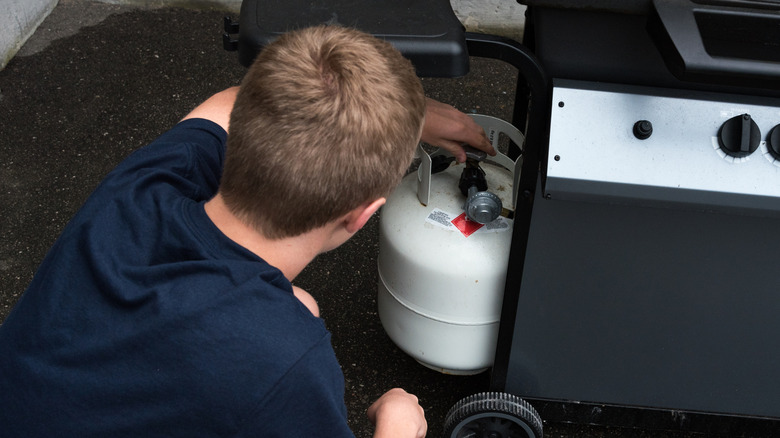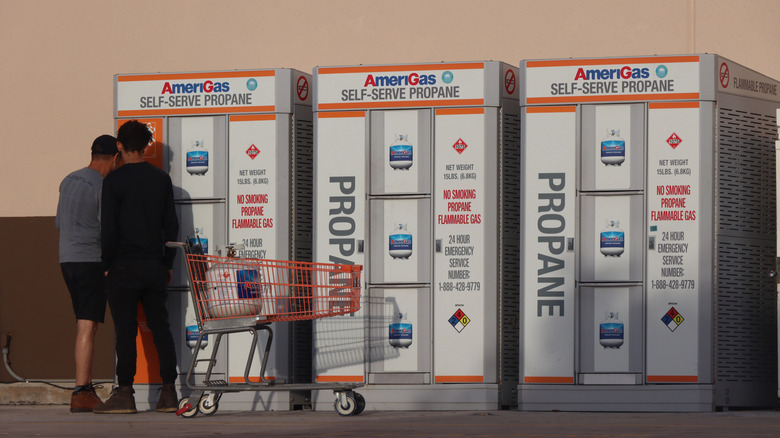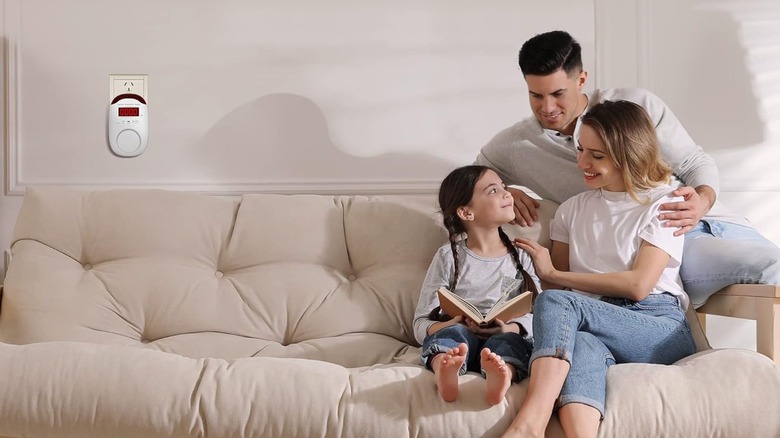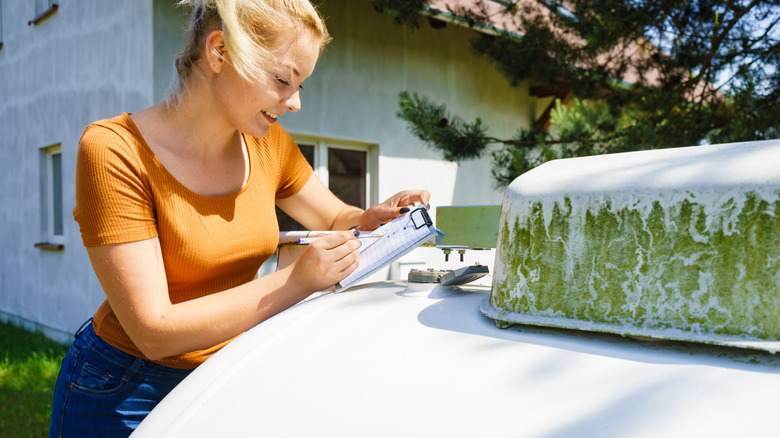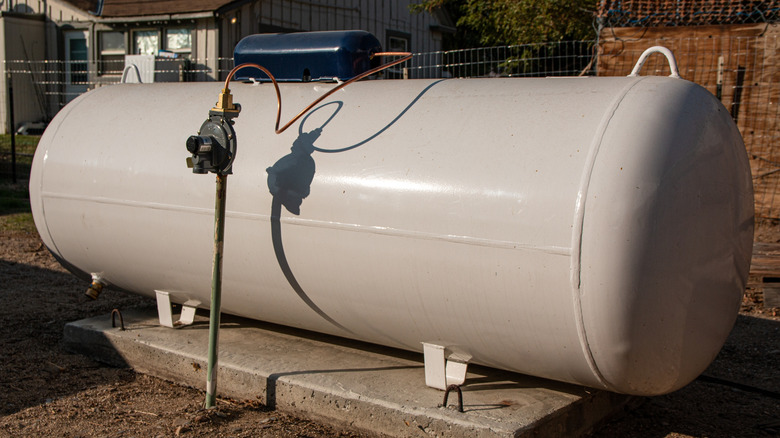Common Mistakes You Should Be Avoiding With Propane Tanks At Home
We may receive a commission on purchases made from links.
Propane is a non-toxic, colorless, and odorless (although manufacturers add odor for safety reasons) gas that can be used in several ways around the home. Also called LPG, the gas is compressed into liquid form and stored in tanks. One type of tank many homeowners are familiar with is a portable propane tank. Commonly called 20-pound propane tanks, gas grill tanks, or grill propane cylinders, these tanks hold 4.6 gallons of propane. There are also larger, whole-home propane tanks, ranging from 250 gallons to 1,000 gallons. Depending on the size of the home and the capacity of the tank, these tanks can help support various different home heating options or even supply propane to power multiple home appliances, including generators or hot water heaters.
While most people feel comfortable utilizing one or both of these, there are various mistakes you can make while transporting, storing, and using propane tanks. These mistakes can compromise your safety, decrease the efficiency of your system, or lead to other costly issues. In the sections that follow, we'll take a look at some of the things you shouldn't do with propane tanks — both for portable tanks and whole-home systems. We'll share some pointers so you can avoid falling victim to one of these errors, and we'll also highlight what you should be doing instead to prevent a potential safety hazard or otherwise costly issue.
Leaving portable propane tanks in direct sunlight
While you shouldn't house portable propane tanks indoors (more on that below), storing them in direct sunlight is also a mistake. If you place propane in a location where the sun is beating down on the tank for several hours a day, the contents may get too hot. You don't want the tank to reach a temperature greater than 120 degrees Fahrenheit. This can cause too much pressure to build up inside. Tanks are designed with pressure relief valves to prevent explosions, however, if the pressure relief valve opens up, it will release gas into the air. If anything flammable is nearby, this could result in a fire.
Instead, choose a shaded area in your yard to store your propane tanks. If you're having a whole-home system installed, the installation company you're working with can help you select the best location in your yard and recommend any modifications to the setup that may be necessary. They will also be able to guide you on any recommended measures to take during heat waves, such as hosing down the tank to reduce the temperature of the liquid propane inside.
Smoking near portable or whole-home propane tanks
Smoking is certainly not a healthy habit, but it can be even more dangerous if you do it near a propane tank. We just told you that you should be storing portable propane tanks in a shaded location outside, which may also be a preferred outdoor smoke break spot. While liquid propane (which is what is stored inside the canister) is not flammable, propane gas is highly flammable. If your smoke break coincides with any gas being released from the tank, whether due to a leak or a buildup of pressure, you're running a big risk. Flames — such as those from the lighter — can cause the propane to ignite, causing a catastrophic explosion.
Fortunately, the chances of a propane canister exploding are low. But why risk it? If you aren't ready to kick the smoking habit, at least be very careful about where you light up your cigarette when there are any propane tanks in the vicinity. Move several yards away from the tank (at least 25 feet for whole-home tanks) before you strike a match or flip on your lighter.
Being unbothered by a small leak from either a portable or whole-home tank
If you suspect your propane tank (whether portable or a whole-home system) has a small leak, your first instinct may be to assume that it's not such a big deal. But this is dangerous: If there isn't sufficient ventilation around the tank, it is possible for you or others in the vicinity to suffer from asphyxiation from breathing in too much propane. If exposure continues over a longer period of time, it can also increase your risk of respiratory issues. Worse, propane gas is highly flammable; if any gas is leaking from a portable or whole-home tank, it could spark a fire if exposed to any ignition source. Even if you don't smoke or purposefully light anything near the tank, there is always the threat of a poorly placed lightning strike or an electrical spark.
Treat any potential propane leak as a serious issue that demands immediate attention. Begin by disconnecting the tank from your grill or turning off the gas line into your home. You can determine where a propane leak is coming from with the help of a little dish soap. Spread a thin layer of soap over the tank, especially around the valve. Then, open the valve slowly and look for any bubbles that are forming around it. If you notice bubbles, they indicate a leak that will need to be addressed urgently. Contact the fire department and move a safe distance away from the home if you identify a leak. As an important note, if you detect a very strong odor, similar to that of a skunk, you should immediately vacate the premises and call the fire department instead of trying to find the leak yourself.
As a general practice, it is also a good idea to follow the steps above to check a portable propane tank for a leak before connecting it to your grill. Even if you don't have reason to suspect a leak, one could still be present. Taking a few minutes of your time to use the soapy solution is well worth the peace of mind and the safety of you and your family or guests.
Attempting to repair a whole-home or portable tank yourself
If you've discovered a leak or another issue with your propane tank, it can be tempting to try to repair it yourself. You may think you can save money with a DIY fix instead of hiring a professional or might feel that you'll be able to get the repair done faster that way. However, regardless of your reasoning for attempting to repair a portable or whole-home propane tank yourself, it will be a mistake to do so. Just as some electrical projects are best left to a professional, the same is true for propane tank repairs.
Let's start with portable tanks. Once damaged, these are not even supposed to be repaired or used again. In fact, many jurisdictions even have laws in place prohibiting damaged tanks from being sold or rented. If you do try to make any repairs or modifications to your portable propane tank, it could open up the possibility of additional problems. Beyond the risk that you won't actually prevent the canister from continuing to leak, you may find that you're not able to have the tank refilled when it is time. Federal law states that propane suppliers may not refill these canisters. Instead, they are supposed to be destroyed.
If you have a whole-home propane tank, it is also illegal to attempt repairs yourself. Beyond being illegal, you could be at an increased risk of carbon monoxide poisoning or causing further damage to the tank. Leave repairs to a qualified professional to avoid these and other potential setbacks and health hazards.
Storing a portable tank on its side
If you store a portable propane tank on its side, you could be making a costly mistake. To know why this is a mistake, you first need to understand one of the key components of a portable propane tank: the pressure relief safety valve. This valve, which is located at the top of the cylinder, is designed to release pressure if/when too much builds up in the canister. This is an essential process. An explosion can occur if too much pressure accumulates in the tank.
The reason why you shouldn't store a canister on its side is because the liquid propane, not the vapor, will be in contact with the pressure relief valve. The valve will only be able to accurately detect high pressure — and open up to release it — if it is in contact with the vapor. So, instead of storing a propane tank on its side, be sure to always leave it upright. Thankfully, the design of the cylinders, with their flat bottom, makes upright storage easy.
Failing to transport portable tanks safely
The last time you picked up a portable propane tank for a backyard barbecue, how did you bring it home? Did you toss it in the trunk or on the floor of your back seat and think nothing more of it? If so, you'll want to change your transportation methods in the future. First, as we just discussed, propane tanks should always remain in an upright position. Otherwise, the pressure relief safety valve won't be able to monitor the pressure and open up to release any excess buildup. Placing the tank on its side in your car — even for a short ride — could make an explosion more likely if excess pressure builds up.
However, simply standing the tank upright may not be sufficient. If you make a sharp turn or need to slam on the brakes, the tank could tip over. To avoid this, you can secure the tank using some cargo straps, such as these Cartman Lashing Straps. Avoid using metal chains as they could potentially damage the tank. If you do not have any cargo straps to keep the tank secured, place it on the floor of the car and use other heavier objects to lock it into place. If you regularly transport portable propane tanks, you could also consider investing in this Mr. Heat Tank Foot. It creates a solid base to keep tanks from tipping over.
Storing portable tanks indoors
As you're deciding where to store a portable propane tank, you might decide that a basement or laundry room is the best location. After all, you've been told to keep them out of hot, baking sunlight. So, a cool and dark spot in your home should be perfect, right? Wrong. Storing propane indoors, especially inside a home, is not a good idea. In the event that too much pressure builds up in the can or there is any ignition source present, you don't want it to explode in the house.
Even the garage isn't the safest storage option for a propane tank. Similarly, there are also dangers to storing extra propane tanks in a shed. While these areas may have better ventilation than a home, they are still pretty enclosed. Plus, depending on the other things you store in the same place (think charcoal briquettes, spare gasoline, or paint solvents), you could be further increasing the risk of an explosion or dangerous fire. Instead, the best place to store a propane tank is outside. Choose a flat, dry, shaded location that can support the weight of the can and which is at least 10 feet away from anything that can emit a flame, such fire pits and patio heaters.
Leaving the gas supply on when not using a grill connected to a portable propane tank
During the summer, you may grill out practically every evening. Leaving the gas supply to your grill on may seem like the most convenient option. Plus, what's the harm that could really happen if you're going to be out to grill the next night, anyway? Unfortunately, this is flawed logic that could open the door for a safety hazard to occur. If the gas supply to the grill is left on, the chances of a gas leak occurring are increased. Whether that leak is caused by a child playing with the knobs on the grill or someone accidentally bumping them, or an animal chewing on the gas line, it won't matter. The result will be the same. An increased risk of a fire or explosion or potential harm to anyone in close proximity to the leak.
Always shut the gas supply off once you've finished using the grill. It takes only a few seconds to turn it off, and then a few more to turn it back on the next time you need to grill. Sparing those few seconds certainly isn't worth the devastation that is possible with an open gas supply.
Not knowing the best (and least expensive) way to refill a portable tank
When your portable propane tank is running low, you'll need to be prepared with a plan if you want to be able to continue grilling, running a patio heater, or keeping your camping stove operational. Fortunately, you don't have to buy a brand new tank each time yours is running low. Instead, you can either exchange your tank or refill it. However, if you don't know the best method and location to get new propane, you could end up spending more than is necessary.
Generally, refilling a propane tank is going to be the more economical option. The per-gallon price is generally lower than you'll pay when exchanging the tank. Plus, if you exchange your tank, any leftover propane will just go to waste. Conversely, when you refill it, you will only pay for the additional propane that is needed to fill it back up. If you do a little comparison shopping, you'll learn that all retailers do not charge the same for a tank refill. While many may be comparably priced, you're likely to find the best deal at Costco. However, before you refill a propane tank at Costco, there are a few important things to know. First, not all Costcos offer this service, so you'll want to confirm that it is provided by your local warehouse. Second, you must be a member in order to refill your tank.
Failing to install detectors for increased safety with whole-home tanks
If you have a whole-home propane system, overlooking the importance of installing detectors will be a mistake. All propane sold to consumers nowadays contains a strong added odor (as the gas is naturally odorless) so that it's easier to detect if there is a leak or gas buildup somewhere. While your nose might alert you, if your tank ever leaks, you want as many fail-safes in place as possible.
A propane leak detector can help avoid potentially catastrophic consequences by catching a leak early. These detectors are installed near the propane tank. They are designed to monitor the air around the tank and track the concentration of the gas. When a higher-than-usual concentration is detected, the alarm will sound. This should give you time to vacate the premises and contact the fire department to address the leak and make sure your home is safe.
Not having whole-home tanks inspected regularly
Prevention is key when it comes to issues with your whole-home propane system. After all, a leak is nothing to joke around with. It could lead to a fire or an explosion, which you certainly don't want in such close proximity to your home. Failing to have your tanks regularly inspected will increase the chances that something may go wrong. As with other household appliances and devices, propane tanks and their various components can become worn over time. If this wear isn't caught soon enough, something could fail, and you could have a propane leak on your hands.
The safest choice is to schedule yearly inspections with a licensed professional. They'll be able to check on the various components of the system, including the tank, valves, regulators, and gas lines, to ensure everything is in good condition and functioning as it should. Beyond decreasing the risk of a gas leak, regular inspections of your system can also ensure that it is operating efficiently. This can cut back on your energy costs. A well-maintained system will also last longer than one that is neglected. Obviously, you want to put off the cost of purchasing a new whole-home propane system as long as possible.
Letting your home propane system run out of fuel
There are several reasons it will be a mistake to miscalculate and let your home propane system run out of fuel. The most obvious one is that without the fuel, none of the appliances or the heating system running off the tank will function. You'll be left waiting for the tank to be refilled before you'll be able to power any of these devices.
However, this is not the only reason you don't want to let your tank run out of fuel. When a propane tank runs out of fuel, you are required by law to have a propane leak test performed. This is not a test that you can perform by yourself, so you'll have to pay a qualified company to complete it for you. Depending on their availability, it could delay your ability to start using your propane-connected devices even further.
